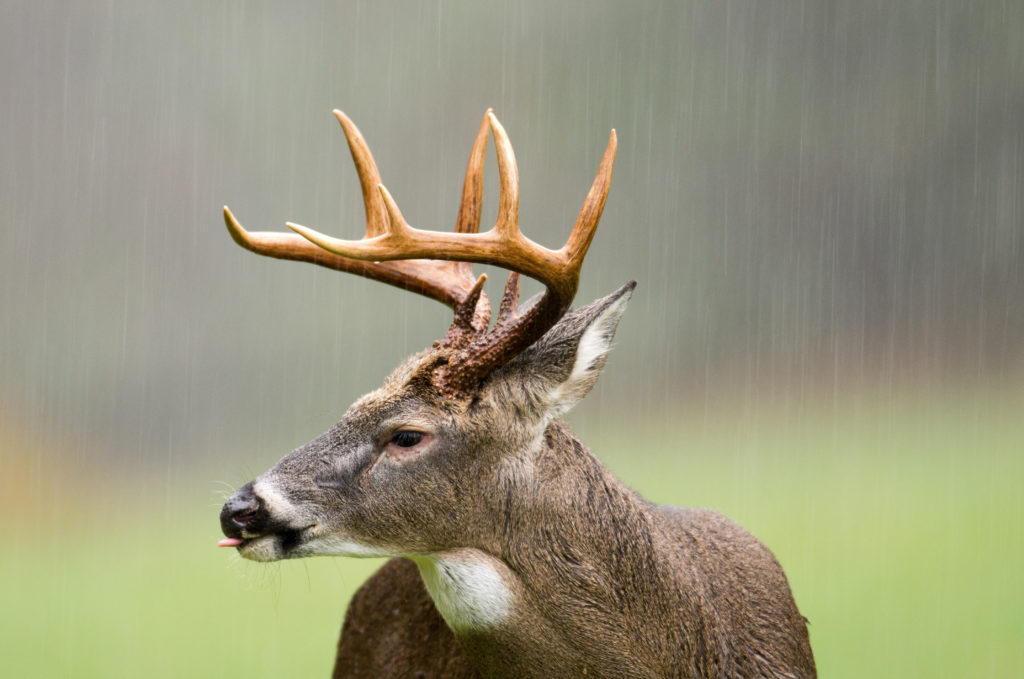Rain. Sure, it’s great for the waterfowler, but what about the whitetail deer hunter? When the rain does indeed drum against the windowpane, isn’t the hunter better off inside? The answer is yes and no.
A debate on hunting whitetails in the rain is a discussion of three elements: myth, truth and practical preparation. Let's tackle myths and truths first.
Myth: When it rains, all deer activity decreases.
To a whitetail, rain is simply something that happens on an irregular basis, and really no reason for a total alteration of routine. The exception to this, and where there is indeed a shred of truth to the myth, are torrential downpours. Driving rain can send deer into hiding, but then again, such rains send everything into hiding — even hunters.
Truth: Hunting in the rain can be uncomfortable; however, it need not be, if you know how to deal with the situation. And we’ll address those issues shortly.
Myth: Hunting deer in the rain is more trouble than it’s worth.
When was the last time you killed a nice buck while making your way from the couch to the refrigerator? Such successes in the rain are few and far between, and while I hate to debate with a cliché, the old adage “You can’t notch your tag from your easy chair” certainly does hold true.
Truth: Yes, hunting in the rain — or for that matter, any type of inclement weather conditions — often brings its own set of trials and tribulations. However, these problems are not without their solutions. The harder you work for your bounty, the more rewarding your hunt will be. Check out my rainy day deer hunting strategies below.
Related: Top 10 non-magnum deer hunting cartridges
Rain and deer activity
A whitetail’s routine is affected little by light rain. However, weather can change where that routine takes place. Here, I’ve separated these possible changes into two categories — sensory changes and bedding or cover changes.
It’s no secret deer rely on their senses of smell and hearing as top lines of defense. Rain can influence both. Swirling clouds of scent molecules, both good and bad, can be rain-washed from the air, making it difficult for deer to smell that which their nose would have otherwise known. The steady pitter-patter of rain on the leaves also fills a deer’s ears with aural clutter (potentially predator-disguising clutter).
Deer recognize these situations and will often attempt to compensate by increasing the emphasis placed upon the third sense — sight. How? Through heightened visual awareness, which is something the animal can accomplish easily by frequenting areas which offer extended fields of vision. Hidden meadows, field edges or power line right-of-ways are three examples. Simply put, go to where deer can see, and you’ll see deer.
Rain can also affect where deer bed both for the night and in the short-term. Typically, light rains will see little or no change in bedding location. However, heavy rains will often push animals into more protective nighttime cover. Weather can also influence where daytime deer can be found, topographically speaking, particularly in very open or vast terrains. Often accompanied by wind, rain can mean a move toward the leeward side of any geographic change in the landscape, be it as slight as a low timbered ridge or as severe as the slope of a 200-foot canyon. Experience can reveal such rainy-day hiding spots. However, these locations can also be revealed with the help of high-definition mapping software or on-line satellite imagery.

A whitetail buck standing in light rain. Credit: iStock
Comfort is key while hunting deer in the rain
Given today’s technologically advanced clothing, footwear and accessories, there’s no reason for the rainy day hunter to be anything but comfortable. Comfort in the rain is all about being prepared; however, comfort doesn’t only mean staying warm and dry on stand. Comfort also means being confident with each and every piece of your hunting equipment — shotgun, rifle, muzzleloader, bow, boots, gloves, hat, jacket, etc.
Pre-season practice breeds confidence, but only if it’s done as realistically as possible. That includes not only the equipment, but also the apparel to be worn under wet conditions. Raincoat and pants. Hood up. Hood down. Long-billed hat. Short bill. No bill. Rubber boots. In other words, 18 feet in a tree stand looking down on a 26-yard, 175-class whitetail is no time to discover your rain jacket doesn’t provide adequate shooting clearance when wet. The rule of practice is simple: Make your mistakes off the playing field, not on it.
Related: What do deer eat?
Rainy Day Deer Hunting Strategies
Rainy day strategies are an individualized thing with tactics that are dependent on the whole of the hunt itself. However, there are guidelines whitetail hunters might consider when anticipating a soggy outing.
- Light rain or drizzle: No change in tactics. In most cases, a light rain has little effect on animal movement. True, normal activities such as feeding might be delayed slightly or, as is often the case on cloudy days, the crepuscular (dawn and dusk) movements might be extended into late morning or early evening. However, either or both changes can been seen as advantageous.
- Moderate rain: A moderate rain calls for some improvisation. Try still-hunting. Cornfields are excellent candidates for such tactics. Reverting pastures, too, especially those with multiflora rose or blackberry thickets are another good choice, as are field edges, pine stands and clearcuts. Where possible, spot-and-stalk can be effective. But it’s important to remember when still-hunting, it’s the eyes and not the legs that spell success.
- Heavy rain: Most hunters (myself included) will wait a heavy rain out. During such toad soakers, every living thing with a brain stem seeks some sort of shelter, as should you. The drying out period following a rain, however, can prove productive as animals resume normal activities.
Featured photo: iStock






